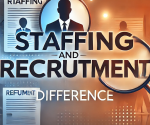The goal of staffing is to assist a company in acquiring, training, and retaining a productive workforce. The primary focus for any staffing function is to make sure that people are assigned to the tasks on time and at the appropriate time. This staffing function is essential for the proper arrangement of human resources within an organization, understanding the requirements of the organization, recruitment of appropriate human resources and nurturing them to suit the needs of the organization. Effective staffing contributes to the improvement of productivity, promotion of employee engagement, and at large the achievement of the organization’s goal through alignment of human capital with the strategic goals or objectives of the organization.
Meaning of Staffing
Staffing is the managerial function that includes recruiting, selecting, training, and developing employees to fully fill organizational roles. This function ensures that employees gain skills, knowledge, or attitudes necessary for contributing towards the success of the organization. Staffing places people systematically into positions in which they can best perform; hence it improves general productivity. Good articulation of a staffing strategy is very central to the success of a business, allowing an effective team to emerge.
Features of Staffing
Staffing has some specific characteristics; these emphasize
e its importance in being a core managerial activity. These characteristics are an important determinant of an appropriate and motivated workforce.
- Orientation toward Human Resources: Staffing is concerned with people and how they can be acquired developed, and trained. The skill levels, attitudes, and abilities of employees are of extreme interest.
- One-time activity: It is not a one-time activity but an ongoing process, as it requires continuous assessment of the needs of the organization and the capabilities of the workforce to maintain a sustainable balance.
- Goal-oriented: The prime purpose of staffing is to align the workforce with the objectives of the organization, which is a very important factor for productivity and growth.
- Dynamic Nature: The process of staffing has to be dynamic so that changes can occur because of the changes in the business environment, advancements in technology, and shifting workforce expectations.
Objectives of Staffing
Objectives of staffing are devised in a way to form an employee population that serves the aim of the organization. Those objectives guide managers on executing their roles in performing the task of staffing successfully.
- Fulfilling Workforce Needs: Staffing ensures that every position within the organization is occupied by qualified individuals. It aims to maximize employees’ strengths by placing them in roles that suit their skills and interests.
- Improving Productivity: A well-staffed organization can achieve greater efficiency, minimizing errors and delays. Staffing strategies are implemented to boost job satisfaction, morale, and motivation among employees.
- Growth: Staffing Promotes Organizational Growth Staffing helps to develop a skilled and motivated workforce, which is vital for the growth of the organization. Staffing acts as the backbone of an organization; it makes any organization successful and long-lived. It lays a solid foundation for the achievement of business goals by a productive and satisfied workforce.
- Recruitment and Selection: Identify and attract qualified candidates for the job opening through different means. Ensures that the organization has the right number of employees with the required skills at the right time
- Employee Development: The training and development of the employee’s skills in order to improve performance and career advancement. Identify the specific responsibilities and requirements of each position in order to have proper staffing.
- Compliance with Legal Requirements: It ensures that all the staffing practices are in tune with labor laws and regulations to avoid facing any legal issues. Identifies and develops internal candidates for key positions to ensure preparation for future leadership needs.

Importance of Staffing
Staffing is the alignment of the organization’s needs with the capabilities of the employees, thus staffing gives an employer a productive workforce that enhances business performance and encourages innovation.
- Right Person for the Right Job: Staffing identifies individuals whose skills align with the job requirements; thus, there is a peak in performance. Staffing matches roles with the abilities of individuals so as to minimize inefficiencies and mistakes.
- Supports Organizational Goals: Proper staffing links human resources to strategic goals, hence encouraging growth and success. The more an employee is suitable for the job, the more likely they are to be satisfied and motivated.
- It Enhances Decision-Making: A competent workforce enhances the decision-making of the organization at all levels.
- It Decreases Recruitment Costs: Wise staffing practices reduce the need for constant recruitment by hiring employees with long-term potential. Thoughtful staffing practices contribute to job satisfaction. When employees feel they are well-matched to their roles, they are more likely to remain engaged and committed to the organization, reducing turnover rates and associated costs.
Functions of Staffing
Staffing performs multiple important functions, all of which are necessary for creating and sustaining an effective workforce. Such functions interplay with one another in order to address the organization’s needs as well as the employee’s development.
- Manpower Planning: Management examines the current and future manpower requirements of the organization to make sure there are adequate human resources. A retail store anticipates an increasing workforce during the holiday seasons.
- Recruitment: This activity attracts qualified applicants using job postings, campus recruitment, and hiring events. However, some of the basic techniques are online job boards, advertisements, and referrals from employees.
- Selection: Organizations choose the best person to join through interviews, evaluations, and checking his/her background history. This may include application screening, interview checking, and reference checking.
- Training and Development: Employees learn new skills and knowledge for their roles. This will not only help them in their current work but also equip them to take on further responsibilities. Example: Technical training in software development.
- Performance Appraisal: The performance of the employees is reviewed by managers to give them constructive criticism and point out areas where they can improve. Methods are 360-degree feedback, KPIs, and rating scales.
- Promotion and Transfers: Staffing also includes promoting employees who deserve it and shifting them to places that coincide with their skills. Example: Promotion from within in order to fill leadership roles.
- Compensation and Benefits: Offering competitive salaries, bonuses, and benefits keeps them at work for producing high performance. For example; offering medical insurance and retirement schemes.
Objectives of Staffing FAQ
What is the primary objective of staffing?
The main goal of staffing is to ensure that the right individuals are in the right positions at the right times. It aims to align the skills of the workforce with the objectives of the organization to drive success.
Why is staffing considered a continuous process?
Staffing is seen as a continuous process because the needs of the workforce evolve due to factors such as business expansion, technological changes, and employee turnover. Organizations need to regularly adjust their staffing strategies.
How does staffing improve productivity?
Staffing enhances productivity by placing employees in roles that match their skills and providing them with the necessary training. This ensures that employees can work efficiently and meet the standards set by the organization.
What are the key functions of staffing?
The main functions of staffing include planning for manpower, recruiting, selecting, training, and developing employees, evaluating performance, and promoting, and implementing retention strategies.
Why is employee retention important in staffing?
Employee retention is crucial because it lowers recruitment costs, ensures stability within the organization, and creates a positive work environment. Employees who stay bring valuable experience and contribute to the long-term success of the organization.


